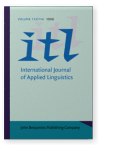Vol. 113/114 (1996) ► pp.203–220
Vol. 113/114 (1996) ► pp.203–220
Testing the acquisition of English productive and non-productive derivatives by native-Arabic speakers
Vocabulary development can be achieved by helping the foreign learner of English to acquire productivity and non-productivity in English derivation. In addition, the English productive derivatives should be given special attention in teaching to and learning by native-Arabic speakers because the Arabic language is a language of derivation and it is highly productive. This paper tests how the adult native-Arabic speakers learning English as a foreign language acquire English productive and non-productive derivatives. This will be done by comparing productivity in standard written Arabic and standard written English through contrastive analysis. The concept of contrastive analysis (CA) is initially called upon the fact that Arabic is a language of productive derivation while English is a language of more than one source of word-formation; borrowing, compounding and derivation. Moreover, productivity in English is not high. Secondly, morphology is subject to avoidance phenomenon by foreign learners. Hence, the predictive value of CA and also its testing in this paper should be very helpful for English teachers to native-Arabic speakers learning English and other foreign learners, language acquisition researchers, applied linguists, methodologists and textbook-writers.
